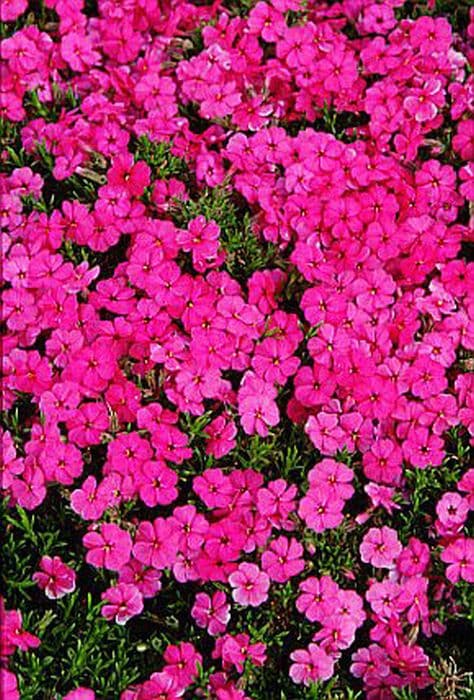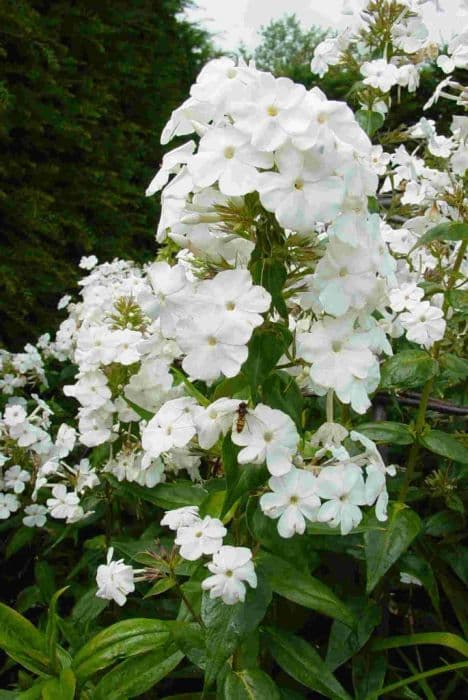Douglas Moss Phlox Phlox douglasii 'Red Admiral'

ABOUT
Phlox douglasii 'Red Admiral' is a delightful flowering plant known for its vibrant and showy appearance. It is a member of the phlox family and typically bears the common name "creeping phlox." This cultivar, 'Red Admiral,' boasts a blanket of blossoms with rich, red hues that make it a standout in any garden setting. The flowers are densely packed and star-shaped, covering the foliage in a striking display that can add a burst of color to rock gardens or front borders. The foliage of the creeping phlox 'Red Admiral' is equally attractive. It consists of needle-like leaves that create a mat-like ground cover, with the foliage maintaining a deep green color throughout the growing season. The leaves are small and fine, offering a pleasing texture that complements the boldness of the flowers. The pairing of the lush, green foliage and the intense red blossoms produces a visually appealing contrast, enhancing the overall allure of the plant. Creeping phlox, while primarily known for its springtime bloom, can also entice with its foliage during other seasons. Some varieties, including the 'Red Admiral,' may show evergreen tendencies, contributing to year-round interest in milder climates. The plant's overall appearance is one that exudes charm and beauty, making it an excellent choice for gardeners looking to add a splash of color and ground-covering capabilities to their garden palettes.
About this plant
 Names
NamesSynonyms
Douglas's Phlox, Red Admiral Phlox
Common names
Phlox douglasii 'Red Admiral'.
 Toxicity
ToxicityTo humans
Phlox is not generally known for toxicity to humans. However, like with any plant, individuals may have varying levels of sensitivity and could possibly experience an allergic reaction if they are sensitive to Phlox or other members of the Polemoniaceae family. If ingested in large amounts, it could potentially cause gastrointestinal upset, though this is not commonly reported. It is always wise to avoid ingesting plants that are not specifically known to be edible and to seek medical attention if any adverse reactions occur.
To pets
Phlox, generally, is not considered toxic to pets such as dogs and cats. However, each pet may react differently and sensitive pets may experience mild gastrointestinal upset if they consume parts of the Phlox plant. It’s always prudent to monitor your pets around garden plants and discourage them from chewing on plants that are not meant for consumption. If you notice any unusual symptoms after your pet has ingested this plant, it is recommended to contact your veterinarian.
 Characteristics
CharacteristicsLife cycle
Perennials
Foliage type
Evergreen
Color of leaves
Green
Flower color
Pink
Height
6 inches [15 cm]
Spread
1 foot [30 cm]
Plant type
Herb
Hardiness zones
5
Native area
North America
Benefits
 General Benefits
General Benefits- Aesthetic Appeal: Adds vibrant red-pink flowers to gardens that can enhance the overall beauty of the landscape.
- Drought Tolerance: Once established, it is relatively drought-resistant, making it suitable for xeriscaping and low-water gardens.
- Ground Cover: Acts as an effective ground cover, spreading over time to cover bare spots and reduce soil erosion.
- Pollinator Attraction: Attracts bees, butterflies, and other pollinators, supporting local ecosystems.
- Easy Maintenance: Requires minimal care once established, making it ideal for gardeners looking for low-maintenance options.
- Long Blooming Period: Offers a long blooming period, typically from spring to early summer, providing prolonged garden interest.
- Cold Hardy: Can withstand cold temperatures, making it suitable for planting in a variety of climates.
- Versatile Use: Ideal for rock gardens, borders, or as an accent plant in mixed beds due to its compact habit.
- Rapid Growth: Establishes quickly and spreads to form a dense mat, offering quick coverage for new or renovated garden spaces.
- Deer Resistance: Typically resistant to deer, reducing the need for protective measures in gardens with a local deer population.
 Medical Properties
Medical PropertiesThis plant is not used for medical purposes.
 Air-purifying Qualities
Air-purifying QualitiesThis plant is not specifically known for air purifying qualities.
 Other Uses
Other Uses- Phlox douglasii 'Red Admiral', commonly known as Douglas's Phlox, can be used in creating perfumes and scented products due to its pleasant fragrance.
- The plant can serve as an educational tool in botany classes to demonstrate ground cover growth habits and survival adaptations.
- Douglas's Phlox can be used in culinary arts to garnish and add color to various dishes, although it is not commonly consumed.
- The blossoms can be incorporated into nature crafts, such as making floral bookmarks or pressed flower arrangements.
- Dye extracted from the petals of Douglas's Phlox may be used in textile arts for coloring fabrics, though this is not a widespread practice.
- In garden landscaping, the plant's vibrant colors can be used to create living paintings or mosaic patterns.
- The plant can be used in butterfly gardens to attract and nurture butterflies, providing an eco-friendly means of insect appreciation and study.
- Douglas's Phlox can be used in wedding ceremonies as natural decor for aisle runners or table centerpieces, emphasizing a wildflower theme.
- The plant's low-growing, mat-forming habit makes it useful in designing green roofs or living walls in urban environments.
- Phlox douglasii 'Red Admiral' can provide visual markers in lawns and pathways when used as a turf substitute in ornamental landscapes.
Interesting Facts
 Feng Shui
Feng ShuiThe Creeping Phlox is not used in Feng Shui practice.
 Zodiac Sign Compitability
Zodiac Sign CompitabilityThe Creeping Phlox is not used in astrology practice.
 Plant Symbolism
Plant Symbolism- Harmony: The Phlox douglasii 'Red Admiral', commonly known as Creeping Phlox, often symbolizes harmony due to its creeping habit, which creates a visually harmonious blanket of flowers.
- Unity: The way Creeping Phlox plants grow closely together and cover the ground has given them the symbolic meaning of unity.
- Agreement: Creeping Phlox is also seen as a symbol of agreement, reflecting the ease with which it adapts to the garden and agrees with the surrounding flora.
- Partnership: The plant’s dense growth is reminiscent of partnership, as it showcases how multiple stems work together to form a single, beautiful display.
 Water
WaterCreeping Phlox requires moderate watering, especially during the first growing season to establish a deep, extensive root system. Once established, they are relatively drought tolerant and do not require frequent watering. Aim to water them deeply approximately once a week, providing about one inch of water which can be roughly 0.4 gallons for a small patch. During hot, dry spells, water them twice a week. In cooler, moist climates, you may only need to water every two weeks if there has been sufficient rainfall.
 Light
LightCreeping Phlox thrives in full sun to partial shade. The best spot for this plant is a location where it receives at least six hours of sunlight per day. If grown in too much shade, its flowering may be reduced. Morning sun with some afternoon shade is ideal, especially in hotter climates to prevent the foliage from scorching.
 Temperature
TemperatureCreeping Phlox grows best in temperatures between 60°F and 70°F, but it can tolerate a range from just above freezing up to 80°F. The plant is cold hardy and can survive winter temperatures down to -30°F. Ideal growing conditions include spring and fall temperatures that average around 65°F, but it's quite adaptable and can withstand fluctuations outside of these parameters.
 Pruning
PruningPruning Creeping Phlox is necessary to maintain its shape and promote vigorous growth. Prune after the flowering season, typically in late spring or early summer, to remove spent flower heads and encourage a second bloom. Cut back the foliage by one-third to half to maintain a tidy appearance and stimulate new growth. Pruning should be done at least once a year, after the main blooming period.
 Cleaning
CleaningAs needed
 Soil
SoilDouglas Moss Phlox thrives best in well-draining soil with a mix of sand, loam, and compost. The ideal soil pH for Douglas Moss Phlox is slightly alkaline to neutral, ranging between 6.5 and 7.5. When preparing a soil mix, emphasize good drainage and moderate fertility, avoiding excessively rich or heavy clay soils which can lead to root rot.
 Repotting
RepottingDouglas Moss Phlox is a hardy perennial that typically does not require frequent repotting. It is usually repotted or divided every 2 to 3 years to rejuvenate the plant and encourage vigorous growth. This also provides an opportunity to replace old soil and inspect the root system for health.
 Humidity & Misting
Humidity & MistingDouglas Moss Phlox prefers moderate humidity and can tolerate the average outdoor humidity levels well. It does not require any special humidity considerations, making it adaptable to many garden environments. Consistently high humidity may encourage fungal diseases, so good air circulation is recommended.
 Suitable locations
Suitable locationsIndoor
Place in bright light, avoid overwatering, ensure good air flow.
Outdoor
Full sun to partial shade, well-drained soil, space adequately.
Hardiness zone
3-9 USDA
 Life cycle
Life cyclePhlox douglasii 'Red Admiral', commonly known as the Douglas Moss Phlox, begins its life cycle as a seed, which upon finding suitable conditions, germinates and develops into a seedling. The seedling grows into a small plant, developing a root system and foliage through vegetative growth. The plant then enters a mature phase, where it produces buds that blossom into vibrant red flowers, attracting pollinators and setting the stage for reproduction. Following pollination, the flowers develop into fruit capsules that contain seeds. Once the seeds mature, they are dispersed, either by the wind, animals, or other means, into the surrounding environment. The plant may continue this cycle annually, generally showing a peak flowering period in late spring to early summer, and can also spread vegetatively through its evergreen mats or rosettes.
 Propogation
PropogationPropogation time
Spring to early summer
The Creeping Phlox, specifically Phlox douglasii 'Red Admiral', is commonly propagated by division, which is best performed in spring or early fall. To propagate by division, one should gently dig up an established clump of phlox and carefully separate the plant into smaller sections, each with a good root system and several shoots. These divisions should then be replanted in well-draining soil, ideally in spots that receive full sun to partial shade. Water the new divisions regularly to ensure they establish a strong root system. This method allows gardeners to quickly and easily increase their Creeping Phlox collection while maintaining the health and vitality of the parent plants.









